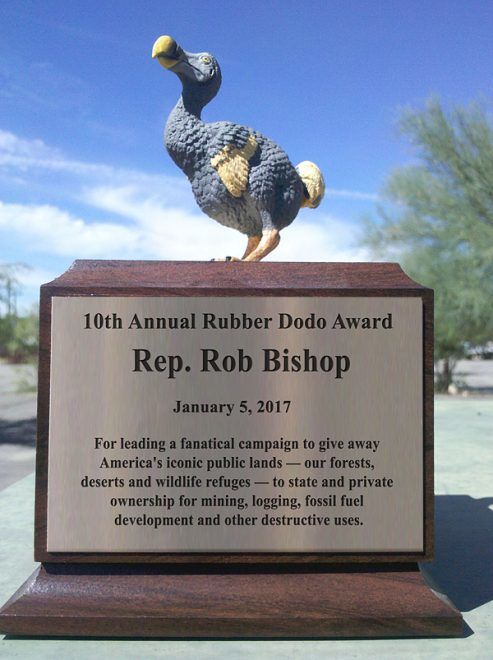
Extremist Agenda to Give Away Public Lands, Kill Off Endangered Species Cited
TUCSON, Ariz.—(ENEWSPF)–January 5, 2017. The Center for Biological Diversity today gave Utah Congressman Rob Bishop its annual Rubber Dodo award. The statue is awarded each year to the person or group who has most aggressively sought to destroy America’s natural heritage or drive endangered species extinct. Bishop, a Republican, is chairman of the House Committee on Natural Resources.
“Rob Bishop has fanatically pursued an extremist agenda to give away America’s public lands and kill off its endangered species,” said Kierán Suckling, the Center’s executive director. “He is so far outside the mainstream that even Donald Trump has rebuked him for his positions.”
In the last few weeks alone, Bishop has called for repealing America’s strongest and most successful conservation law, the Endangered Species Act, pushed through a congressional rule requiring that bills seeking to give away federal public lands be treated as revenue neutral, regardless of their costs to federal and state governments, and advocated rescinding the recently created Bears Ears National Monument.
“Rob Bishop must go to sleep every night dreaming of ways to steal public lands away from the American people,” said Suckling. “These forests, deserts, rivers and streams are home to thousands of species of wildlife and are a source of inspiration and wonder to millions. But Bishop’s doing everything he can to turn them over to polluters, developers and oil companies.”
Bishop won the Rubber Dodo award after an online contest where tens of thousands of people were asked to choose between him and William Clay, deputy administrator of USDA’s Wildlife Services; former Volkswagen CEO Martin Winterkorn; and former Exxon CEO Lee Raymond.
Previous Rubber Dodo award winners include Monsanto (2015), the U.S. Department of Agriculture’s Wildlife Services (2014), the Koch brothers (2013), climate denier Senator James Inhofe (2012), the U.S. Chamber of Commerce (2011), former BP CEO Tony Hayward (2010), massive land speculator Michael Winer (2009), Alaska Gov. Sarah Palin (2008) and Interior Secretary Dirk Kempthorne (2007).
Background on the Dodo
In 1598 Dutch sailors landing on the Indian Ocean island of Mauritius discovered a flightless, 3-foot-tall, extraordinarily friendly bird. Its original scientific name was Didus ineptus. (Contemporary scientists use the less defamatory Raphus cucullatus.) To the rest of the world, it’s the dodo — possibly the most famous extinct species on Earth after the dinosaurs. It evolved over millions of years with no natural predators and eventually lost the ability to fly, becoming a land-based consumer of fruits, nuts and berries. Having never known predators, it showed no fear of humans or the menagerie of animals accompanying them to Mauritius.
Its trusting nature led to its rapid extinction. By 1681 the dodo had vanished, hunted and outcompeted by humans, dogs, cats, rats, macaques and pigs. Humans logged its forest cover while pigs uprooted and ate much of the understory vegetation.
The origin of the name dodo is unclear. It likely came from the Dutch word dodoor, meaning “sluggard,” the Portuguese word doudo, meaning “fool” or “crazy,” or the Dutch word dodaars meaning “plump-arse” (that nation’s name for the little grebe).
The dodo’s reputation as a foolish, ungainly bird derives in part from its friendly naiveté and the very plump captives that were taken on tour across Europe. The animal’s reputation was cemented with the 1865 publication of Lewis Carroll’s Alice’s Adventures in Wonderland.
Based on skeleton reconstructions and the discovery of early drawings, scientists now believe that the dodo was a much sleeker animal than commonly portrayed. The rotund European exhibitions were likely produced by overfeeding captive birds.
The Center for Biological Diversity is a national, nonprofit conservation organization with more than 1.1 million members and online activists dedicated to the protection of endangered species and wild places
Source: http://biologicaldiversity.org








